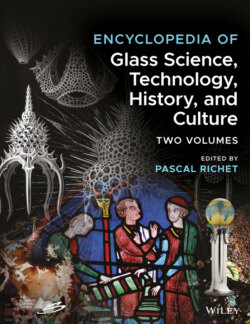Читать книгу Encyclopedia of Glass Science, Technology, History, and Culture - Группа авторов - Страница 261
4.1 Al3+ and Qn‐Species
ОглавлениеWhere there is excess alkali metal or alkaline earths over that needed for charge‐balance of Al3+ in tetrahedral coordination, Al3+ may be distributed among the various Q n ‐species. However, this distribution is not random and Al3+ dominantly is in Q 4‐species. Coexisting, less polymerized Q n ‐species are essentially devoid of Al3+. This situation reflects the tendency of Al3+ to substitute for Si4+ in SiO4 tetrahedra with the smallest intertetrahedral angle, which is found in Q 4‐species.
It follows that the equilibrium constant for the reaction, 2 Q 3 ⇌ Q 2 + Q 4, is positively correlated with Al/(Al + Si) of the glass and melt. For peralkaline alkali aluminosilicate melts (see Figure 1) at temperatures above their glass transition, the temperature‐dependent equilibrium constant yields ΔH‐values increasing from near 0 to about 40 kJ/mol in the Al/(Al + Si) = 0–0.4 range. Fewer experimental data exist for peralkaline alkaline earth aluminosilicate glasses.
In chemically complex environments with both alkalis and alkaline earths present, the alkali metals associate with the Al3+ in the Q 4 species, whereas alkaline earths tend to bond with NBO in depolymerized species [10]. It follows, therefore, that for systems such as natural magmatic liquids, the Q n ‐distribution is controlled for the most part by the rules that govern alkaline earth compositions.
This can be illustrated with the use of experimental data from ternary aluminosilicates to model the properties of chemically more complex systems. For example, the physicochemical properties of aluminosilicate glasses and melts, which vary with (Si,Al)─O bond energy, can be related qualitatively, and sometimes semi‐quantitatively, to the Al/(Al + Si) ratio and to the electronic properties of charge‐balancing cation because the bond energy varies with these same variables. The viscosity and activation energy of viscous flow of melts along meta‐aluminosilicate joins, which are essentially fully polymerized, follow such simple evolutions within temperature intervals where the temperature‐dependent viscosity is approximately Arrhenian (Figure 9). In contrast, the viscosity of peralkaline aluminosilicate melts does not show this effect of Al/(Al + Si) and actually may have a minimum at intermediate Al/(Al + Si)‐values (Figure 9). This difference is because of a combination of weakening of (Si,Al)─O bonds in Q 4‐species with increasing Al/(Al + Si) and changing Q n ‐species abundance with increasing Al/(Al + Si).
Figure 9 Activation energy of viscous flow of aluminosilicate melts along the NaAlO2─SiO2 (nominal NBO/T = 0) (meta‐aluminosilicate) join (closed squares) and Na2Si2O5─Na2(NaAl)2O5 (nominal NBO/T = 0.5) (peralkaline aluminosilicate) calculated with the assumption of Arrhenian viscosity of the melts. As discussed in the text, NaAlO2─SiO2 melts and glasses do have a small fraction of a percent nonbridging oxygen, but are essentially pure Q 4 with Al‐substitution for Si. Melts and glasses on the Na2Si2O5─Na2(NaAl)2O5 join, on the other hand, comprise Q 2, Q 3, and Q 4 species with essentially all Al3+ in substitution for Si4+ in the Q 4 species thus weakening the (Si,Al)─O bridging oxygen bonds in this specie. This, in turn, lowers the activation energy as for the NaAlO2─SiO2 melts and glasses. However, because of Al‐preference, the proportions of Q n ‐species change so that Q 4 abundance increases, thus countering the effect of the Al,Si‐substitution. These two mechanisms give rise to the minimum activation energy values at intermediate Al/(Al + Si) values.
The compressibility and thermal expansion of alkali aluminosilicate melts are also correlated with Al/(Al + Si) because the intertetrahedral (Si,Al)─O─(Si,Al) angle is itself more compressible and expandable with increasing Al/(Al + Si). In alkaline earth aluminosilicate systems, however, the opposite relations exist because Ca‐charge‐balanced Al3+ causes the (Si,Al)─O─(Si,Al) bonds to stiffen. In other words, the compressibility and thermal expansion of such aluminosilicate melts decreases with increasing Al/(Al + Si).
Among the main groups of natural magmatic liquids (basalt, andesite, and rhyolite), the proportion of alkaline earths/alkali metals in charge‐balancing roles decreases in the same order. This means that basaltic melts are less compressible and show smaller thermal expansion than more silica‐rich melts such as rhyolite. Furthermore, the viscosity of basalt melt is less sensitive to Al/(Al + Si) than more silica‐rich magma, which have a higher proportion of alkali‐charge‐balanced Al3+ in tetrahedral coordination.
